Papers by Kirstie Galbraith
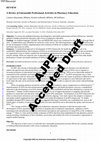
American Journal of Pharmaceutical Education
Objective. To review the published literature describing how entrustable professional activities ... more Objective. To review the published literature describing how entrustable professional activities (EPAs) are currently utilised in health professional education with a focus on pharmacy education. Findings. An English-language CINAHL Plus and MEDLINE search was conducted for January 2011 through March 2021. 21 publications were identified for inclusion in this review. The following themes were identified: frameworks for the development of EPAs, implementation and evaluation of EPAs for workplace learning and gaps in knowledge and future directions for EPAs. Summary. A standardised approach to development of EPA frameworks for health disciplines has yet to be established. Implementation and evaluation of EPAs as an educational tool in the practice setting is also inconsistent. An opportunity exists to further establish the development, implementation and evaluation of EPAs in all clinical practice settings. EPAs are relatively new in pharmacy practice settings and much can be learned from other health professions to ensure successful translation of EPAs into pharmacy education.
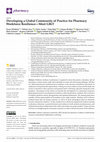
Pharmacy, 2021
Workforce resilience in pharmacy is required to ensure the practice, education, and administrativ... more Workforce resilience in pharmacy is required to ensure the practice, education, and administrative systems remain viable and sustainable over time and when facing challenges. Whether it is addressing burnout of pharmacists or students, or the structure and policies/procedures of employment and professional organizations, working to increase resilience across all individuals and sectors is essential to relieve pressure and promote better well-being, especially during the recent pandemic. The purpose of this article is to describe the development of a community of practice global group focused on development of resilience within the pharmacy workforce that is inclusive of students, pharmacy interns/preregistration and registered pharmacists. The steering group meets monthly and has representation of 24 members across eight countries. Members meet to discuss pertinent issues they are facing in practice, as well as to share and progress ideas on education, research, and practice initiat...
The Canadian Journal of Hospital Pharmacy, 2020
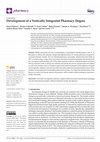
Pharmacy, 2021
Whilst curriculum revision is commonplace, whole degree transformation is less so. In this paper ... more Whilst curriculum revision is commonplace, whole degree transformation is less so. In this paper we discuss the rationale, design and implementation of a unique pharmacy program by a research-intensive faculty. The new Monash pharmacy curriculum, which had its first intake in 2017, was built using a range of key innovations that aimed to produce graduates that demonstrate key conceptual understanding and all the skills required to deliver world-best patient outcomes. The key elements of the re-design are outlined and include the process and principles developed, as well as key features such as a student-centred individualised program of development arranged around specific, authentic tasks for each skill and earlier enhanced experiential placements where students become proficient in entrustable professional activities. It is hoped the dissemination of this process, as well as the lessons learnt in the process, will be useful to others looking to transform a health curriculum.
The Senior Care Pharmacist, 2020
The pharmacy degree at Monash University is a four year undergraduate Bachelor of Pharmacy with H... more The pharmacy degree at Monash University is a four year undergraduate Bachelor of Pharmacy with Honours (BPharm(Hons)), followed by a one year Master of Pharmacy incorporating a preregistration year of supervised practice, known in Australia as internship. The first cohort of the BPharm(Hons) will graduate in 2020. A key principle of the new curriculum was that clinical experiential placements should commence early in the curriculum, be fully integrated with the didactic curriculum, and prepare students for internship by developing their competence in performing useful and relevant tasks in the workplace. Entrustable Professional Activities (EPA) are used as the framework for their experiences.
Bulletin of the World Health Organization, 2020
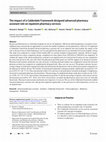
International Journal of Clinical Pharmacy, 2020
Background Pharmacists in Australian hospitals do not see all inpatients. Effectively utilising p... more Background Pharmacists in Australian hospitals do not see all inpatients. Effectively utilising pharmacy assistants in nontraditional roles may provide an opportunity to increase the number of patients seen by pharmacists. Objective To implement a Calderdale Framework designed advanced pharmacy assistant role on an inpatient unit and evaluate the impact of the role on the provision of clinical pharmacy services provided by the pharmacist in an Australian University hospital. Setting The study was conducted in a single 24-bed medical IPU at a tertiary hospital in Queensland, Australia. Method A quasiexperimental two-cohort comparison design, completed over three phases from 30/5/2016 to 30/9/2016 was employed. To evaluate the impact of the advanced pharmacy assistant on an inpatient unit an 8-week period of usual care was compared to the same time period on the same unit where the pharmacist provided usual care with the support of an advanced assistant. Pharmacist and assistant satisfaction was also surveyed. A training and lead-in phase was completed to ensure the advanced pharmay assistant was competent in completing the delegated tasks. Main outcome measure The primary outcome was percentage change of medication management plans documented by the pharmacist with an advanced assistant comparative to the pharmacist without. Results The number of documented medication management plans significantly increased by 9.5% (p = 0.019; CI 1.86-17.14). Plans documented within 24 h and time to documentation remained unchanged. Completeness increased in community pharmacy documentation. The percentage of completed discharge medication records rose by 15.6%, (p < 0.001; CI 7.78-23.16). Interventions documented increased by 55 and the percentage of patients with clinical reviews documented increased by 35%. There were fewer missed doses recorded and pharmacists spent more time on clinically based tasks. Pharmacist and assistant satisfaction also improved. Conclusion The use of the Calderdale Framework enabled structured pharmacy assistant role redesign that impacted significantly on the provision of clinical pharmacy services on an inpatient unit.
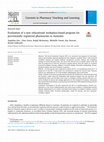
Currents in Pharmacy Teaching and Learning, 2020
The Intern Foundation Program (IFP) is an innovative new program for intern pharmacists (provisio... more The Intern Foundation Program (IFP) is an innovative new program for intern pharmacists (provisionally registered pharmacists) that integrates academic theory with structured workplace learning and regular feedback, incorporates research training, and streamlines training of clinical educators (CEs). The aim of this research was to evaluate aspects of the IFP from the perspectives of both CEs and interns, gauging opinion about the impact on workload, structured workplace learning, addition of research training, CE-student relationships, CE standardized training, and intern transition to practice. Methods: Two focus groups were conducted to explore CE (N = 6) and pharmacy intern (N = 7) perspectives of the IFP. A topic guide was constructed to address the research aims. Thematic analysis was undertaken by two team members independently then in discussion. Results: Both the CE and intern groups reported that the IFP enabled more structured supervision and fostered a better intern-CE relationship with beneficial support from the university. IFP standardized rubrics and checklists used as part of workplace learning assisted with more consistent feedback for interns and training approaches for CEs alongside CE training. Participants also reported that undertaking a research project provided them with enhanced learning and new skill development. Conclusions: Participants in the pilot agreed that the IFP is a valuable program, deemed complementary to the intern training program that assists intern transition to independent practice through implementation of a unique curriculum based largely on workplace learning, research training, fostering better CE-intern relationships, robust CE training, and close universityworkplace support.
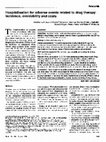
Medical Journal of Australia, 1996
Main outcome measures: The number, type, causality and avoidability of drugrelated admissions. Re... more Main outcome measures: The number, type, causality and avoidability of drugrelated admissions. Results: Of 965 admissions, 55 (5.7%) were assessed as being drug-related. Drugrelated admissions (DRAs) were designated possibly (38%), probably (46%) or definitely (16%) drug-related; caused by prescribing factors (26%), patientnoncompliance (27%) and adverse drug reactions (47%); and classified as definitely (5.5%), possibly (60.0%) and not (34.5%) avoidable. The estimated annual cost to the hospital for all DRAswas $3496956 and for unavoidable DRAs was $1629494. Conclusion: The DRA rate we found lies around the middleof the range of other published rates. Few DRAswere judged definitelyavoidable and over one-third were unavoidable. Nevertheless, the largestproportion werejudged possiblyavoidable. As the drugs identified in this study are clearlyneeded in the community, effortsto reduce DRAsmust concentrate on education, counselling and monitoring of drug therapy.
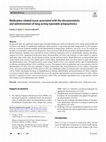
International Journal of Clinical Pharmacy, 2019
Background There are significant research gaps into understanding the extent of medication errors... more Background There are significant research gaps into understanding the extent of medication errors within mental health and variation in the uptake of standardised medication safety practices. Long-acting injectable antipsychotic (LAIA) preparations are a common treatment modality for the administration of antipsychotic medicines. Aim of the review To examine the literature on medication-related errors and practice issues associated with the documentation and administration of LAIAs. Method Electronic databases were searched for articles exploring medication errors in mental health, charting and administration of LAIAs, standardised medication charts, documentation of LAIAs and strategies or interventions to improve medication safety with LAIAs. Results Nineteen articles met the inclusion criteria. Medication errors in mental health were mostly related to the clerical or procedural aspects of prescribing. Standardised charts have been shown to reduce prescribing and administration errors. Divergent practices across mental health services were reported and this lack of standardisation in ordering and administering LAIAs contributes to errors. Discrepancies between guidelines and current practice with the administration of LAIAs were also identified. Evidence demonstrates that clinical pharmacy services reduces medication errors, and increased pharmacist involvement in LAIA care coordination improves communication and documentation with LAIAs. Further investigation focusing on standardisation of charting, administration and documentation of LAIAs is required. Conclusion Limited studies were identified that assess the charting, administration and documentation of LAIAs. Future research is required to review current local practices with LAIAs and identify substandard areas so that specific clinical interventions can be implemented and evaluated.
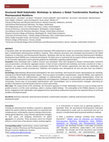
INNOVATIONS in pharmacy, 2018
In November 2016, the International Pharmaceutical Federation (FIP) endeavored to create an env... more In November 2016, the International Pharmaceutical Federation (FIP) endeavored to create an environment to foster a shared vision to lead a transformative pharmaceutical workforce roadmap. Three milestone documents were developed and presented at the Global Conference on Pharmacy and Pharmaceutical Education. Workshops with the key themes and connecting Pharmaceutical Workforce Development Goals (PWDG) were conducted and analyzed. This Note serves to summarize the key aspects of these workshops, reporting on the innovative approaches used to generate guidance for stakeholders regarding implementation. Innovation: Seven workshops with a uniform structure were developed. These were designed to improve communication, harmonise outcome-generation, and allow for aggregate analysis. A team of seven conducted each workshop, each team consisted of: a Chair, a facilitator, one rapporteur, and four speakers purposively selected from FIP member organisations and other key stakeholders with e...
Medical Journal of Australia, 2017
Objectives: To evaluate whether pharmacists completing the medication management plan in the medi... more Objectives: To evaluate whether pharmacists completing the medication management plan in the medical discharge summary reduced the rate of medication errors in these summaries. Design: Unblinded, cluster randomised, controlled investigation of medication management plans for patients discharged after an inpatient stay in a general medical unit.

The Australian Journal of Hospital Pharmacy, 2000
Aim: To describe the pilot implementation of guidelines for the standard documentation of clinica... more Aim: To describe the pilot implementation of guidelines for the standard documentation of clinical pharmacy activities in clinical practice settings in a range of Australian hospitals.Methods: Twenty‐eight hospital pharmacies participated in the study conducted over a 5‐day period in June 1999. Pharmacists recorded patient‐specific clinical activities as defined in the set of documentation guidelines, documented their experience and provided feedback during and at the end of the study period. Participants were also asked to provide suggestions on potential performance indicators for clinical pharmacy and to comment on four proposed indicators.Results: 18 402 clinical activities were documented by 85 pharmacists. The most frequent clinical activities performed (% of total activities) were medication order review (53%), clinical review (21 % ), medication history interview (8%) and patient medication counselling (7%). The definitions were deemed to be suitable for most activities. Wit...

Journal of Pharmacy Practice and Research, 2003
Objectives: To determine the current and possible future utilisation of pharmacy technicians in c... more Objectives: To determine the current and possible future utilisation of pharmacy technicians in clinical pharmacy support roles in Australia. To use the information to develop a set of potential support tasks for pharmacy technicians working under the supervision of clinical pharmacists.Method: The Society of Hospital Pharmacists of Australia Committee of Specialty Practice in Clinical Pharmacy undertook a survey of Australian clinical pharmacy managers to determine current and possible future involvement of pharmacy technicians in components of clinical pharmacy activities described in The Society of Hospital Pharmacists of Australia Standards of Practice for Clinical Pharmacy. The survey was mailed to 275 hospital pharmacy departments in January 2002. A reference group of Australian pharmacists and technicians was then formed to consider the survey results and reach consensus on potential clinical pharmacy support activities suitable for technicians.Results: The survey response ra...
The Australian Journal of Hospital Pharmacy, 1998
Specialist clinical pharmacy certification is available from the American Pharmaceutical Associat... more Specialist clinical pharmacy certification is available from the American Pharmaceutical Association through its Board of Pharmaceutical Specialities (BPS). Four Australian pharmacists who were supported by the Society through its Grants and Awards program describe the experience they gained in preparing for, and successfully sitting, the examinations in pharmacotherapy and psychiatry. The examinations are well conducted, clinically relevant and rigorous. As more Australian practitioners take the BPS exam, there will be a group able to work with the Society in making relevant specialist professional qualifications more accessible to Australian pharmacists.
Australasian Emergency Nursing Journal, 2015
A total of 549 patients had medications charted by a pharmacist from the 14th of November 2012 to... more A total of 549 patients had medications charted by a pharmacist from the 14th of November 2012 to the 30th of April 2013. A total of 4765 medications were charted by pharmacists with 7 identified errors, corresponding to an error rate of 1.47 per 1000 medications charted. Conclusions: Partnered medication review and charting by a pharmacist in the Emergency Short Stay and General Medicine unit is achievable, safe and effective. Benefits from the model extend beyond the pharmacist charting the medications, with clinical value added to the admission process through early collaboration with the medical officer. Further research is required to provide evidence to further support this collaborative model.

Journal of Pharmacy Practice and Research, 2015
Background An Advanced Pharmacy Practice Framework for Australia (the ‘APPF’) was published in Oc... more Background An Advanced Pharmacy Practice Framework for Australia (the ‘APPF’) was published in October 2012. Further to the release of the APPF, the Advanced Pharmacy Practice Framework Steering Committee planned to develop an advanced practice recognition model for Australian pharmacists.AimTo gauge the perspectives of the pharmacy profession relating to advanced practice, via an online survey, in order to inform the design of the model.MethodA survey was developed and administered to Australian pharmacists through SurveyMonkey . The survey content was based on findings from a review of national and international initiatives for recognition of advanced practice in pharmacy and other health disciplines, including medicine and nursing.ResultsThe results of the survey showed that a high proportion of respondents considered they were already working at, or working towards achieving, an advanced level of practice. The responses relating to the assessment methods showed a clear preferenc...
Journal of Pharmacy Practice and Research, 2012
Journal of Pharmacy Practice and Research, 2006
ABSTRACTAn online Australian Pharmacy Preceptor Education Program was developed to enable pharmac... more ABSTRACTAn online Australian Pharmacy Preceptor Education Program was developed to enable pharmacists to access education and support to assist with their responsibilities as preceptors. The program was designed to improve the effectiveness of their supervision while enhancing their satisfaction with the role. Mentoring is also an important aspect of professional involvement with students and graduates. The importance of mentoring to succession planning, professional satisfaction and self esteem was recognised and a mentoring module was also developed for inclusion in the program. This paper describes mentoring as a practice, the process of developing the mentoring module and provides an overview of its content.
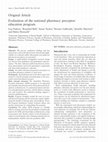
Australian Journal of Rural Health, 2007
Objective: The process evaluation findings and key issues from a trial of the effectiveness and ... more Objective: The process evaluation findings and key issues from a trial of the effectiveness and national applicability of a national online educational curriculum for pharmacist preceptors are presented. Design: A multi‐method triangulated research design was used to elicit qualitative and quantitative data preceptors. The data collection method involved an anonymous questionnaire with both quantitative components and open‐ended qualitative responses. Setting: An online education program for preceptors of Australian pharmacy students in rural areas. Participants: Rural pharmacists in the three states were invited to trial the package and participate in the associated research/evaluation project. Main outcome measures: The Australian Pharmacy Preceptor Education (APPE) program is an important and valuable educational tool for the professional development of pharmacists. It contained pertinent information and appropriate activities, and the delivery strategy was well accepted. Th...

Uploads
Papers by Kirstie Galbraith